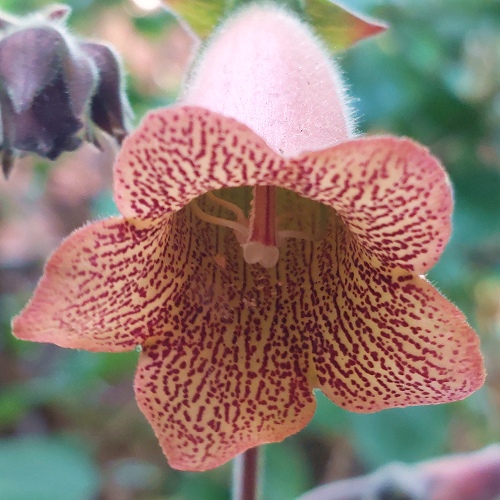Sinningia stapelioides Germinating the seeds
Getting started -- Plant your seeds when you receive them. Use several small pots or cups with drainage holes, about 2-4 inches (5-10 cm) tall. Use a well-draining soil mix. A typical mix is 2 parts
quality potting soil Sprinkle a few seeds evenly across the surface of each pot. An easy way to pick up the seeds is by breathing on your finger tip to lightly moisten it, then dabbing the seeds with it. Don't sow them too densely, because the germination rate is high. Add water until the soil is evenly moist, but not soggy. Enclose the pots in a clear container or bag so the soil always stays moist. Leave it open slightly to let in some fresh air. You may need to drip a few drops of water on the surface each day or two to keep it moist. The seeds germinate well between about 65-80 degrees F (18-27°C). I don't have experience germinating them outside this temperature range. I recommend placing a minimum/maximum thermometer next to the pots. Place the containers in a bright spot out of direct sun. A bright LED lamp kept 4 inches (10 cm) away provides the right amount of light (See: "Growing indoors with LED lights"). The seeds should start sprouting within about 3-4 weeks, but might take longer. Continue dripping water on the soil surface while the seedlings are small, since they have a small root system. The first few weeks, try to avoid letting water sit on the leaves. Increase the air ventilation slightly after they sprout, but keep them above 70-80% humidity until they are a few months old, then gradually lower it. When the seedlings are about 2 months old, you may carefully dig them up and transplant them. It's normal for young seedlings to have more than one leaf. Fertilizing -- The first 3 months, feed
every 2-3 weeks with a small amount of dilute (1/8 strength) liquid fertilizer.
Hydroponic fertilizer
is ideal for small seedlings, because it is easily absorbed and contains all essential
nutrients. After 3 months, you may switch to a granular fertilizer Watering -- Once the seedlings are 4 weeks old, you may stop keeping the soil surface moist at all times. Aim to keep the rest of the soil evenly moist (but not soggy). Lighting -- The plant likes filtered sun or part sun. It might need some protection from strong afternoon sun. Despite what some say, it doesn't need natural light or short days to flower. It flowers for me under an LED panel that's on 16 hours per day. Climate -- It comes from a mild climate, so it grows well for me indoors between 60 and 80 degrees F (16-27°C). I don't know how much cold and heat it's able to take. Over about 40% humidity is best for older plants. Dormancy -- The tuber will drop its foliage each year and go dormant for a few months. Keep the soil lightly moist throughout dormancy. The first dormancy, you can keep it at normal room temperature, but when it's dormant the second year, place the pot in a cool spot with nights below 60⁰F (16⁰C) but above 45⁰F (15⁰C), perhaps on the floor of a cool room. This seems to help encourage flowering. After 2-3 months, return it to a warmer spot. Make sure the soil doesn't dry out during dormancy, since that seems to inhibit flowering. If you have any questions or problems, feel free to contact me. Have fun growing them! - Jeff Strange Wonderful Things
|
|||||||||


